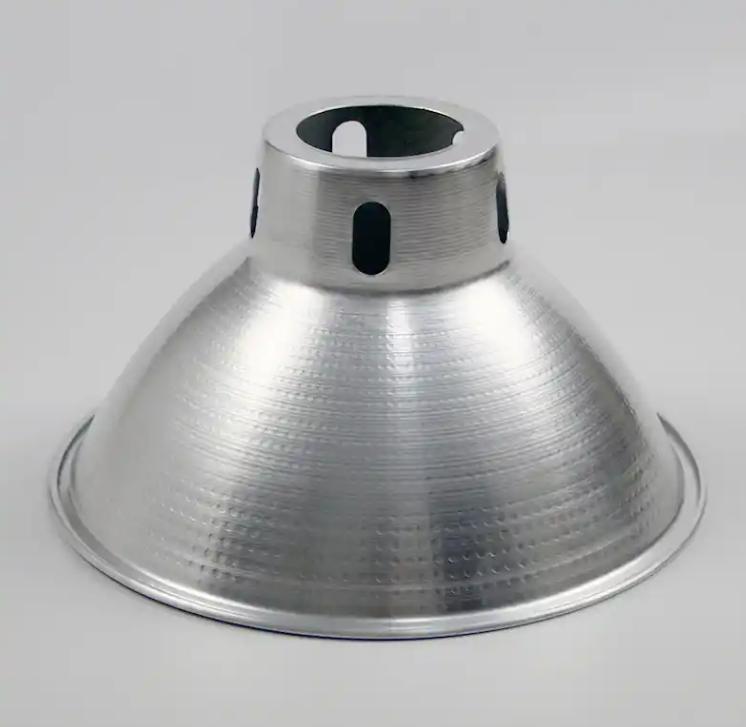Lighting Aluminum Circles vs. Other Materials: Which Is Better for Your Lighting Project?
Δημοσιευμένα 2025-09-18 07:43:40
0
1χλμ.

When designing or sourcing components for lighting fixtures—whether LED downlights, ceiling lamps, or outdoor floodlights—choosing the right base material for reflectors, heat sinks, or decorative rings is critical. Among the top options are lighting aluminum circles, plastic, steel, and ceramic. Each material has unique strengths in cost, heat management, durability, and aesthetics, but only one may align with your project’s goals. Below, we compare lighting aluminum circles to other common materials to help you decide.
1. Heat Management: Aluminum Circles Excel at Cooling
Lighting fixtures (especially high-power LEDs) generate significant heat—excess heat shortens bulb lifespan and reduces brightness. Here’s how materials stack up:
- Lighting Aluminum Circles: Boast excellent thermal conductivity (200–230 W/m·K), meaning they quickly transfer heat away from LEDs to the air. This keeps fixtures running cool, extending LED life by 30–50% compared to poorly cooled alternatives. Their flat, uniform surface also distributes heat evenly, avoiding hotspots.
- Plastic: Has very low thermal conductivity (0.2–0.5 W/m·K). It traps heat, leading to frequent LED burnout—making it unsuitable for high-power lighting (e.g., commercial downlights). Only viable for low-wattage fixtures like nightlights.
- Steel: Offers moderate conductivity (45–50 W/m·K), but not enough for high-performance lighting. It also retains heat longer than aluminum, risking overheating during prolonged use.
- Ceramic: Conducts heat well (30–40 W/m·K) but is brittle—slight temperature shifts can cause cracking, limiting its use in outdoor or high-vibration settings.
2. Durability: Aluminum Circles Balance Strength and Lightness
Lighting fixtures need to withstand wear, moisture, and (for outdoor use) harsh weather.
- Lighting Aluminum Circles: Are lightweight (about 1/3 the weight of steel) yet durable. They resist corrosion (especially when anodized or painted) and won’t rust—ideal for damp areas like bathrooms or outdoor gardens. They also bend without breaking, making them easy to shape into custom fixture designs.
- Plastic: Degrades over time from UV exposure (turning brittle or yellow) and is prone to cracking if bumped. Not suitable for long-term outdoor or high-traffic use.
- Steel: Is strong but heavy, adding bulk to fixtures. It rusts easily without a protective coating, requiring extra maintenance (e.g., repainting) for outdoor use.
- Ceramic: Is scratch-resistant but fragile—dropping or installing it roughly leads to breakage, increasing replacement costs.
3. Cost-Effectiveness: Aluminum Circles Offer Long-Term Value
Budget matters, but “cheap upfront” often means higher costs later.
- Lighting Aluminum Circles: Have a moderate upfront cost (higher than plastic, lower than ceramic). But their long lifespan (10–15 years) and minimal maintenance (no repainting, no replacement from overheating) make them cost-effective over time. They’re also easy to mass-produce, lowering per-unit costs for large projects.
- Plastic: Is the cheapest upfront but needs frequent replacement (every 2–3 years for outdoor use), driving up long-term costs.
- Steel: Costs more than aluminum and requires additional spending on anti-rust coatings, eroding its value.
- Ceramic: Is the most expensive—its brittle nature and high production costs make it impractical for budget-conscious or large-scale projects.
4. Aesthetics & Versatility: Aluminum Circles Fit Any Design
Lighting fixtures aren’t just functional—they contribute to a space’s style.
- Lighting Aluminum Circles: Are highly customizable. They take anodization (for matte or metallic finishes in silver, black, or gold), painting, or printing well, matching modern, industrial, or minimalist designs. Their smooth, uniform surface also enhances light reflection, boosting fixture brightness by 10–15%.
- Plastic: Has limited finish options (mostly matte or glossy solids) and looks cheap in high-end spaces. It also diffuses light poorly, dimming fixture output.
- Steel: Can be painted but has a heavy, industrial look that clashes with sleek, modern designs. Its rough surface also scatters light unevenly.
- Ceramic: Offers a classic, elegant look but comes in limited shapes (mostly round or square) and is hard to customize for unique designs.
Final Verdict: Choose Based on Your Project’s Priorities
- Pick plastic only for low-wattage, short-term, or budget-thin projects (e.g., disposable holiday lights).
- Pick steel if you need extreme strength (e.g., industrial floodlights) and don’t mind the weight or maintenance.
- Pick ceramic for high-end, low-traffic indoor spaces (e.g., luxury hotel lobbies) where aesthetics outweigh cost and durability.
- Pick lighting aluminum circles for 90% of projects—they balance heat management, durability, cost, and aesthetics, making them ideal for residential, commercial, and outdoor lighting alike.
For lighting projects that demand reliable heat dissipation, long-lasting durability, and customizable design, Lanren Aluminum’s lighting aluminum circles—engineered for optimal thermal performance and easy customization—are the smart, value-driven choice.
Αναζήτηση
Κατηγορίες
- Art
- Causes
- Crafts
- Dance
- Drinks
- Film
- Fitness
- Food
- Παιχνίδια
- Gardening
- Health
- Κεντρική Σελίδα
- Literature
- Music
- Networking
- άλλο
- Party
- Religion
- Shopping
- Sports
- Theater
- Wellness
Διαβάζω περισσότερα
Saudi Arabia Cosmetics Chemicals Market Size, Share & Forecast Analysis to 2030
Saudi Arabia Cosmetics Chemicals Market Size & Insights
According to MarkNtel Advisors study...
Domestic Booster Pump Market : Supply Chain, Pricing, and Forecast 2025 –2032
"Executive Summary Domestic Booster Pump Market Trends: Share, Size, and Future...
Magic: The Gathering – Netflix Series Release & Details
After decades of dominating tabletops, Magic: The Gathering conjures an animated journey onto...
Will Byers' Journey – Noah Schnapp Confirms Identity
Will Byers' Journey: Noah Schnapp Confirms Character's Sexual Identity
Throughout the...
Dominik Szoboszlai: Ratings Reload Card & FC 26 Coins
Introduction About Dominik Szoboszlai
Dominik Szoboszlai, born on October 25, 2000, in...


